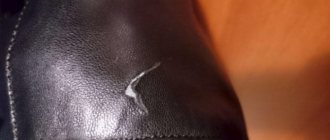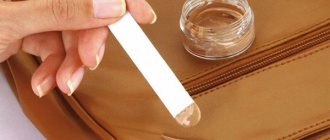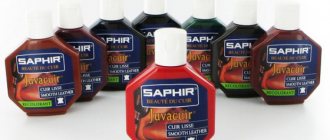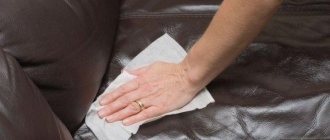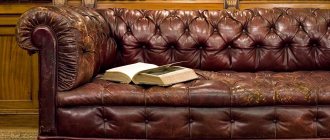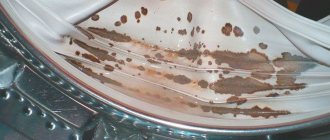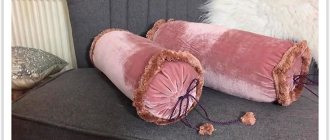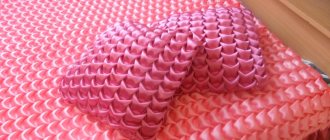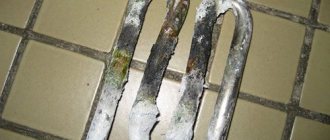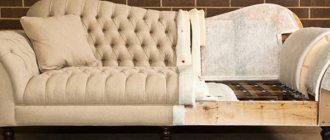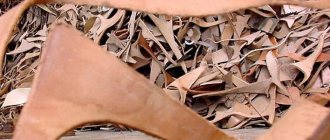Share on social media networks:
Artificial leather is used for the production of haberdashery goods, clothing, shoes, furniture upholstery, and car seat covers. The finished coating is obtained by applying a textured polyurethane film to a cotton base. This film is safe for human health and allows air to pass through well. Things and furniture made from eco-leather are wear-resistant to abrasion, scratches and other damage. Any product becomes unusable over time, so in order not to complicate the situation even further, it is necessary to take timely measures. Today we will tell you how to restore leatherette with your own hands. You will be presented with several simple options for solving this problem.
“Liquid” leather for repairing leather products: reviews, advantages
Despite the successes of the petrochemical industry, which supplies us with synthetic products, in life we are still surrounded by products made from natural materials, including genuine leather. This material is highly susceptible to various mechanical influences. Even a small dog can seriously scratch a new leather sofa, and it's very frustrating. A scratch on a brand new leather jacket or shoes is no less frustrating. Everyone knows this. With “liquid skin” these problems will disappear.
Previously, in such cases, people went to workshops where specialists offered repair services. This took a lot of time and money. Today, with the help of modern technologies, you can carry out minor repairs to leather products right at home. “Liquid leather” for repairing leather products will help with this. Reviews of this material indicate the high effectiveness of funds in this area.
Repairing rips and deep cuts
Restoring leather sofas is also possible in case of large tears. The surface can be revived using liquid leather, as well as more traditional patches and overlays.
Liquid leather for furniture restoration
Liquid leather is a special mixture of polymers, alcohol, dyes and resin. It has the consistency of a thick paste. Liquid leather is placed into the hole in the upholstery, pressed with a dry cloth and a hot iron for two seconds. The paste will fill the hole and, if the color is chosen correctly, the upholstery will look like new from the showroom.
Sometimes, in order to obtain the desired shade, several paste colors are mixed together. It is also important to first try applying the paste to an inconspicuous area and wait for it to dry. This is necessary in order to check how the color will look in the end.
Idea . If the upholstery on the sofa has an unusual texture, then during the repair process you need to press a sample of such upholstery onto the liquid leather. The patch will “copy” this texture and will therefore be invisible.
buybuy
It is easier to choose the right liquid leather and paint for black upholstery, although this color also has many shades
Patch for a cut on a leather sofa
If your furniture has cracks or cuts, they can be repaired in another way. Patch such damage using a square of leather of the same color. It is advisable that it be slightly thicker than the upholstery itself - otherwise it can be easily torn again. This piece needs to be squeezed under the crack. Sew upholstery with small stitches that are invisible at first glance.
Advice . The seams will be more neat and correct if you use special accessories for repairing furniture upholstery.
These patches can be placed on a leather sofa with noticeable cuts.
Leather sofa repair tools
Patches
Applications are the same as patches, but they are placed on the outside. They are not hidden, but rather highlighted. Such stripes can be colored or have an unusual shape. Not every sofa has appliqués. So, on upholstery with a carriage screed they will look alien. But on some models of armchairs and sofas this technique looks organic and creative. This primarily applies to furniture in a youthful, rustic or bohemian style.
It is best to glue applications to the skin with rubber-based glue or another product suitable for the skin. To do this, the surface must be degreased with alcohol, then apply a thin layer of glue and press the sticker.
Decorating using the patchwork technique will help out if you need to inexpensively repair furniture
If none of the above proposed methods saves the situation, they move on to more radical measures - the upholstery is completely replaced. Until then, the damage can be hidden under a blanket.
Leatherette sofa repair: it all depends on the scale of the problem
The first thing to do is to assess the scale and nature of the damage. Typically, people need to tidy up their sofa upholstery for the following reasons:
- spots appeared on it;
- cracks, scratches or tears have appeared on it in one or two places;
- it had completely fallen into disrepair - it was worn out, large holes formed on it.
It is quite easy to deal with stains, scratches and small tears on a sofa made of leather, both natural and artificial. But doing a complete re-upholstery yourself is more difficult.
Minor sofa upholstery repair
If we are talking about cracks, severe abrasions and other damage to the surface of artificial leather, then a detergent, of course, will not help. To prevent the space from becoming larger, its edges can be sealed with tape. But this is a temporary measure, and such repairs to the sofa upholstery don’t look very good. How to restore artificial leather so that the damage is not noticeable at all? If you have material in the right color, use it. How to seal the damaged area? Just cut a piece of the desired shape and size, spread it with superglue, carefully apply it to the break and press.
What to do if you don't have the material in the right color?
If the scratch or tear is not very large, you can use special paints or sprays. All you need to do is apply the indicated product to the damaged skin and wait a bit for it to dry. Apply several coats of paint or spray to achieve the desired thickness, but be careful not to leave unsightly marks on the surface.
Today there are complete kits for restoring damaged artificial leather on sale. These include:
- several jars of paints of different colors;
- pieces of fabric that differ in texture;
- spatula for applying a suitable product.
These kits are generally designed for car owners who need to spruce up their seats. But they are also great for renovating a sofa in your living room or bedroom.
Another useful product is “liquid synthetic leather”. It is an alcohol-based polymer. Use it to repair sofa upholstery as follows:
- you need to take a piece of bandage or gauze in size corresponding to the location of the injury;
- apply it to the damaged area;
- apply the solution with a spatula;
- wait 10-15 minutes for it to dry.
What to do if your eco-leather jacket is cracked?
Has your favorite jacket lost its former shine, and has scuffs, creases and other damage appeared on the surface? How to restore a leather jacket - let's take a closer look at your next steps:
- Assess the extent of damage. This must be done first of all so that you understand what kind of repair the product needs and how much time it will take. First of all, you need to inspect the jacket; if there is severe damage on its surface, then to restore it you need to use deep dyeing products, and the repair process itself will be painstaking and long.
Important! Small scratches on artificial leather should be removed immediately after they are identified. This must be done to further preserve the item and protect it from more serious damage to the material.
- Do the repairs yourself. It is advisable to do such actions only in case of minor defects on eco-leather. If you decide to restore severely damaged leatherette on your own, then you risk damaging the product.
- Use the services of qualified specialists. The best way out of this situation is to contact a professional. This is due to the fact that working with natural and artificial materials requires special care, skills and adherence to restoration technologies.
Restoring the appearance of shoes with cracks in leatherette
To repair such shoes, we buy vinyl leather. This is a synthetic piece of fabric coated with polyvinyl chloride. Unfortunately, in this way it will be possible to repair only isolated damage. If your shoes have a lot of cracks that have burst, you will have to replace them with leatherette. Also, a single damage can be repaired by applying a special patch to it, which can be purchased at a fabric store.
Important! In order for the work to be of high quality, when performing repairs, it is necessary to adhere to a certain technology.
Methods for repairing various defects on eco-leather
Carefully examine the thing you are going to restore, determine the type and scale of the “disaster”. You can repair an eco-leather product in different ways. Which one depends on the type of damage. Let's take a closer look at them.
Stains, abrasions, microcracks
If the upholstery has acquired an unkempt, dull appearance over time, then it must be thoroughly cleaned of stubborn dirt and stains. For deep cleaning, use concentrated soapy water, then wipe dry and gently treat with 70% alcohol or wine vinegar.
Grease stains are effectively removed by dishwashing gel: apply it to the stain and leave for 2-3 hours, then remove with a damp cloth.
You can get rid of old stains using gasoline: apply a little of it to a soft sponge, lightly rub the stain and leave for 30-40 minutes. Remove with a sponge soaked in soapy water.
You can renew worn upholstery on a sofa, ottoman, armchair or car, as well as get rid of cracks using several means:
- Olive oil. You can take the cheapest one. Apply the oil to the damaged area and rub it in using a cotton pad in a circular motion. Wait 1-1.5 hours until the oil is completely absorbed. Evaluate the result and, if necessary, repeat the procedure.
- Shoe polish. Colorless will add shine, colored will paint over minor scuffs. It is important to choose a cream that exactly matches the color of the product and, after painting, wait until it dries completely.
- Permanent marker. Its ink is highly water resistant. Clean the surface from dirt. Carefully outline the microcracks with a marker that exactly matches the color of the product. Wait 20-30 minutes. It can be applied in several layers.
- Pigmented varnish. Suitable for eco-leather with a glossy finish. Rare shades, for example, very bright ones, are obtained by mixing primary colors. Apply to a degreased surface.
- Special paint. Carefully select the tone - if you don’t find the perfect match, take a tone a little darker. Before painting, degrease the fragment with alcohol. Spray aerosol paint with smooth movements at a distance of 20-30 cm, apply the composition from the jar with a slightly moistened foam sponge, patting. The applied layer must be very thin to avoid cracks. Try not to paint “healthy” areas of the surface; if smudges form, remove them immediately with a dry sponge. After drying, the paint can be reapplied.
Try to remove stains on eco-leather immediately. To prevent abrasions and microcracks from appearing on it for as long as possible, regularly wipe it with care products - waxes, oils, polishes. This will not only protect the product, but will also repel dust and dirt from it.
Scratches, punctures, snags
Scratches and snags are damage to the top layer of material. They are often left by cats. To get rid of scratches and punctures, you can use the following tools:
- Nail polish. After cleaning, carefully apply the polish in a very thin line. You can take transparent or close to the color of the coating. For a matte surface - matte varnish, for a glossy surface - regular.
- Furniture touch. The method of action resembles a clerical touch. You can find it in specialized furniture stores. Shake the bottle vigorously before use. Apply it in 2-3 layers using a brush. Wait until it dries completely, then wipe the treated area with a soft, damp cloth.
- Furniture wax. It can be soft and hard. Simply rub the scratches with soft wax. If there are a lot of them and they are large, then use a spatula or a regular kitchen knife. Leave for 15 minutes, carefully remove excess. Polish the treatment with a cotton cloth. Hard wax is more practical and stable, but working with it requires skills. First you need to melt it, then treat the scratch itself and the area around it. This must be done quickly, since hard wax hardens within a minute. Finally, the treated area should be sanded well with a flannel cloth.
Another special product for masking scratches is a colored furniture pencil. It is effective, but does not last long - it must be constantly updated.
Cuts, cracks
Cuts and cracks are more complex damage than surface snags, since they affect the entire structure of the material, right down to the filling of furniture or car seats. To eliminate the defect, you can use superglue or universal leather glue. Apply it to the crack with a toothpick or match. Then press the edges tightly for a few seconds. Wipe off excess glue immediately. If the glue is noticeable, polish it and use paint.
If the defect is very large, then glue alone will not be enough - you will have to install an internal patch. Use eco-leather that is identical in texture, and if you are going to paint the patch, it does not matter what color it is. Using tweezers, insert the patch under the cut and straighten it out. Sand the back side with grit sandpaper - this will enhance adhesion. Using a thin stick, apply glue to the underside of the eco-leather around the cut and, aligning the edges, press firmly with your hand. To ensure everything sticks exactly, place a weight on the patch for 1 hour. If necessary, polish and paint.
Gaps, holes
If eco-leather upholstery has been seriously damaged, for example, a cigarette hole has appeared, or a tear with torn edges, then the optimal restoration is repair with a unique camouflage agent “liquid leather”. It contains glue, coloring matter, and rubber resin. It restores glossy and matte textures equally well.
Repair gaps using a polymer mixture as follows:
- Level the damaged surface, cut off protruding pieces, fibers, and severely deformed areas.
- Wipe the surface with liquid detergent, degrease, and dry.
- Glue the places where the edges meet. For large holes, apply internal patches as described above in the “Cuts” section.
- Sand when the glue is completely dry.
- Apply the prepared composition with a brush of a convenient size or a piece of foam rubber. The required shade can be created by mixing the base tones of the product. During application, smudges may form - you can remove them and level them with a regular ruler or a flat and hard object similar to it. The first layer should be the thinnest. After 2-3 hours you can apply a second one.
- Do not use the restored product until the mixture has dried - 24 hours.
- Polish with a soft cloth. If the treated fragment lacks shine, then coat it on top with a transparent or pigmented varnish.
You can also make “liquid skin” yourself. To do this, take a piece of leather that is close in shade to the product you are repairing. Place 1-2 drops of acetone solvent on the outer surface of the piece. Scrape off the peeling paint with a knife blade - this will be the substance you are looking for. Use it as intended.
When applying liquid special agents to large areas, the most important thing is to recreate a relief “skin” pattern. To do this, we recommend treating small defects with a brush - it will help add texture. And for fragments larger than 2 cm², use a template napkin. It is created like this: a restoration agent is applied to a regular napkin, applied to a “healthy” surface with a clearly visible pattern, and dried. Then, with this “template” you can create natural unevenness during subsequent repairs of eco-leather.
There are defects that cannot be masked by any special compound: large “creeping” cracks, holes. Such areas can be repaired using overlays or appliqués that are placed on top of the upholstery. You need to understand that they will greatly change the appearance of furniture or car seats, but will help stop further growth of tears. When deciding on the shape and color of the stripes, show your imagination. Contrasting abstract patterns or concrete images look original. Place external artistic patches on glue, after degreasing the damaged area.
Do not try to sew up very cracked eco-leather with thread and needle. Firstly, it looks sloppy. Secondly, a needle, even the thinnest one, will leave punctures and provoke new ruptures.
Restoring eco-leather is a painstaking, almost jewelry-like process. To make you happy with the result, carry out repairs in a timely manner - do not wait until a small puncture becomes a big hole.
How to Renew the Look of Natural Leather
The coating may be completely intact, but at the same time have a shabby appearance or marks that are difficult to remove. Cleansers or dyes help combat this. Let's start with tips for painting furniture.
Recommendations for painting leather furniture
The places on the upholstery that bear the heaviest load eventually peel, peel and lose their original color. But for leather sofas this is not a problem at all. This gives them an interesting vintage look. And natural material can always be painted. Now there are a huge number of high-quality dyes. At the same time, for each type of upholstery you need to select your own type of paint - for smooth, for patent leather, for suede and for nubuck. There are instructions on the packaging of each of them. And we will give general recommendations for coloring:
- The easiest way to choose paint is for a dark black and snow-white sofa. To obtain other shades, the paint will need to be mixed. Moreover, you need to immediately tint a sufficient amount of paint, because it will not be possible to repeat such a shade a second time.
- Before applying paint, the surface must be cleaned and degreased.
- During the process you will need a soft textile cloth or sponge. With its help, smudges are eliminated and paint is leveled.
- It is better to make the first layer as thin as possible so that it dries evenly. After the first layer has completely dried, the second one is applied.
- Some people use a hair dryer to speed up drying. But natural leather does not like hot air. It is better to let the chair or sofa dry at room temperature.
To paint a sofa in such a complex shade of brown, you will need to mix several colors
buybuy
Eco-leather, unlike natural material, cannot be painted
buybuy
Only a professional can achieve the desired shade of green
Before painting furniture, apply the tinted composition to an inconspicuous place and wait until it dries to check whether the resulting shade matches the desired one.
Manufacturing process
Eco-leather is a two-layer material , the bottom layer of which is made of fabric, and the top layer is a layer of polymers; they give the appropriate texture and the desired color. Cellulose, polyethylene, rubber, and protein substances are used to make the polymer layer. The United States was an innovator in the production of eco-leather, and soon Japanese specialists began to develop developments in this direction.
Most often, the following materials are used for the base :
- cotton is a natural fabric obtained from cotton;
- polyester is a synthetic fabric made from polyester fibers.
The top layer is best made from pouleritan, a rubber substitute. The bulk of it in industry is used for the production of shoe soles and car tires. This material is also used in the production of glue, sealant, paints and the like. The advantage of polyurethane is its high wear resistance and durability.
In its structure, this material has a porous structure and allows air to pass through , which improves the properties of eco-leather. In addition, polyurethane eco-leather is completely safe and free of chemical odor. The characteristic “leather” pattern on the surface of the material is obtained under high pressure. You can distinguish eco-leather from natural leather by the reverse side of the product. The woven base immediately reveals its artificial origin. In addition, eco-leather cannot be warmed up with the warmth of your hand; it always remains cold.
Storing a Leather Jacket
Leather jackets should be stored on a hanger
In order for your favorite jacket to delight you with its pristine appearance for many years, you need to take care of it not only during wear, but also to ensure optimal conditions during long-term storage.
To prevent the jacket from losing its shape, it must be stored on a hanger; it must not be folded, as this can lead to the formation of creases and cracks.
After hanging the jacket, it is advisable to cover it with a cover made of breathable fabric.
To prevent the skin from losing its properties, it is necessary to maintain a certain humidity and temperature. The storage location must be well ventilated and dry.
The ideal parameters are a temperature of about 20° and a humidity of 50-60%.
How to restore eco-leather on a sofa
Leather furniture looks impressive and stylish. People are increasingly refusing to buy expensive sofas and armchairs upholstered in natural leather due to high costs and ethical principles. An inexpensive alternative has become eco-leather, which in appearance is practically no different from natural leather, and in some respects even surpasses it.
Liquid leather is rightfully considered the best material for the restoration and restoration of ecological leather. The polymer material fills cracks, cuts, marks from teeth and claws.
Restoration work is carried out in several stages:
- the surface is leveled, threads and fibers are removed;
- the edges of the cut or hole are carefully stitched or glued from the inside;
- eco-leather is wiped with liquid detergent and dried;
- the desired shade is selected by mixing several basic colors;
- liquid skin is applied with an art brush or foam rubber;
- The repaired sofa is left to dry for a day.
How not to ruin your sofa completely
If abrasions and damage occupy a large area, then the furniture cannot be restored. It is also unlikely that a sofa upholstered in eco-leather in an exotic color (light green, turquoise, coral, terracotta, lilac) will be able to return to its original appearance. At home, it will not be possible to recreate a complex and ornate design using a napkin or a piece of old leather.
A little about the choice of materials for repairs
The leader among manufacturers of restoration pastes is the French company Saphir. Restoring cream extends the service life of damaged, worn and discolored products. The product is suitable for smooth surfaces; when applied, it creates a durable and elastic layer that repels water. Saphir does not stain clothes and dries quickly.
If you find scratches on leather furniture, clothes or shoes, you should not be upset. There are effective ways to remove imperfections from leather surfaces at home.
Moreover, in some cases there is no need to purchase expensive ingredients; it is enough to know the properties of the products at hand.
This product belongs to professional restoration, it is reliable and effective.
Using liquid leather, otherwise called water-soluble polymer, you can get rid of scratches, abrasions, cracks, cuts and even tears on a bag, clothing or any other product.
The composition of the product is similar in consistency to gouache, so there are no difficulties with restoration.
Apply a thin layer of water-soluble polymer to the damaged area, then apply pressure with a dry sponge to create relief. Leave to dry. If the result is not satisfactory, then the procedure should be repeated.
We do shoe restoration this way.
- We determine the amount of damage. You need to run your hand over the defect. When the roughness is felt only as you move in one direction, the material itself is damaged; if in different directions, only the paint is damaged.
- You need to remove the protruding pieces with nail scissors or tweezers, then smooth out the damaged area with any gentle fine abrasive (manicure buff). Don't rub too hard.
- We clean the area with alcohol or a special composition.
- Apply liquid skin to the defect. The main thing is to accurately select the shade of the polymer. Distribute the product evenly over the entire damaged area so that the transition is invisible. Leave for 15 minutes. Polish. If one treatment was not enough, then liquid skin can be applied two or three more times. Each layer must be allowed to dry for fifteen minutes before applying the next!
- Treat the damaged area with milk or balm.
If the damaged surface was processed correctly and the color of the polymer was chosen correctly, the result will exceed all expectations: there will be no trace of the defect.
The setting time of the water-soluble polymer is from 10 minutes to half an hour. Final drying occurs after 24 hours.
There is a commercially available water-soluble polymer designed specifically for varnished surfaces.
Step-by-step instructions for use
It is best to treat cuts not with glue, but with liquid putty
Repairing leather furniture with your own hands is a simple process, but quite responsible. Below are detailed instructions on how to repair a leather sofa.
Instructions for using liquid leather for cutting furniture
- First of all, it is necessary to clean the damaged area from broken fibers and glue the edges of the crack or tear. To achieve the best results, the crack can be sewn up in several places, and the hole can be pre-sealed from the inside.
Damage to furniture upholstered in light leather
- Degrease the surface of the leather sofa with detergent and dry thoroughly.
Washing a leather sofa before restoration
- Choose the right color for “liquid skin”. If you need to choose a complex color scheme, the kit includes a special table of colors and tones. With their help, you can determine the color scheme that needs to be mixed to obtain the desired shade.
If the cut is deep, you need to glue the inside or make a patch
Table of liquid leather color combinations for the product
- Apply the mixture to the prepared area of the leather sofa. This can be done with a brush or a piece of foam rubber.
Applying liquid skin with a spatula to damaged areas
- Smooth the layer of product applied to the damaged surface of leather furniture. If you don’t have a spatula at home, you can do this with an unnecessary ruler or plastic card.
Upholstery looks better after the second coat
- Remove any contact with the repaired area before the mixture is completely dry.
Useful notice. To give the repaired area a porous pattern that matches the entire surface of the leather sofa, it is necessary to glue a piece of leather (natural or artificial) of the appropriate texture to the surface being treated and press firmly for a few seconds.
In the absence of a fragment of fur, you can create your own template from an ordinary paper napkin. To do this, a layer of the mixture is applied to it, and the napkin is applied to the undamaged area, where the relief appears especially clearly. After this, the resulting stencil should dry completely. Used in the same way as in the first option.
The result of wearing liquid skin with before and after photos
There are times when, when restoring leather furniture, the result obtained does not live up to expectations. This is mainly due to the following reasons:
- the leather sofa has a large defective area;
- wrong skin tone;
- ignore the recommendations established in the instructions for use of the product;
- The pattern of the piece of leather used for embossing does not match the overall texture of the surface of the leather sofa.
The result of the correct color of liquid leather for repair
How and with what to clean a leather sofa at home - 12 ways
Leather furniture looks impressive and is a decoration for any room. There is only one problem - not everyone knows how to wash this furniture correctly so as not to spoil the appearance. It is worth considering all the nuances of cleaning a leather sofa and the rules for caring for it.
Sources
- Puzakov S. Ya. Personnel Directory, in 2 volumes. T. 2; Prometheus - M., 2022. - 448 p.
- Daria Mikhailovna Moshkova Educational and scientific organizations as subjects of financial law; Prospect - M., 2012. - 450 p.
- Irina Anatolyevna Alabastrova Constitutionalism as a legal basis for social solidarity. Monograph; Prospect - M., 2009. - 815 p.
- Citizen and Law No. 08/2011; Gostekhizdat - Moscow, 2011. - 510 p.
- Lovtsov Dmitry Systemology of legal regulation of information relations in the infosphere; Gostekhizdat - Moscow, 2022. - 394 p.
Care method
The structure of the material consists of two layers:
- microporous polyurethane film with a printed surface of natural composition on the top layer;
- polyester base.
The combination ensures ventilation and moisture permeability. Therefore, product care is carried out quickly and without special costs.
You have these rules on how to care for eco-leather on furniture:
- avoid strong friction of the upholstery, do not press intensely;
- wipe with slightly damp towels so that excess moisture does not penetrate between the layers;
- Place sofas and armchairs made of this material away from sources of heat and light.
On a note! Use soft rags for cleaning. Polishing is allowed with products intended for genuine leather. Rub the surface once a year with a water-repellent preparation.
Some practical recommendations
Very often, many people have to look for ways to repair leatherette. The main task of restoring eco-leather is to recreate the relief pattern. If the area is small, it is recommended to paint it with a brush. To do this, first of all, the surface should be degreased. This is necessary so that the polymer material adheres better to the eco-leather.
Places of cuts, scratches and punctures must be cleaned of protruding fabric fibers. Next, you need to glue gauze from the inside of the cut.
Liquid leather must be applied in two main stages:
- First, apply the thinnest layer of the composition to the damaged surface.
- Then the second layer should be applied. But it is recommended to do this after 3 hours.
After about a day, the restored skin dries completely.
It is worth noting that this method is ideal for those products that have a smooth surface. And in order to be able to recreate the relief, you need to use an ordinary napkin. To do this, place a napkin on a clearly embossed pattern. (It is recommended to apply a napkin only after 2 layers have been applied.) After this, this area must be dried for 10 hours.
Faux leather is cracking - what to do
Modern artificial leather is a high quality material. It not only looks beautiful, but also has good performance characteristics. But if the leatherette is cracked, what should you do in this case? Is it possible to somehow solve the problem on my own or will I have to turn to professionals?
Much depends on how severely the faux leather is damaged. If the cracks are large and continue to expand, it is best to contact a professional. And minor defects can be corrected yourself.
How to remove household stains from leatherette
To remove traces of tea and coffee from your skin, you need to do the following:
- Ammonia should be diluted in water;
- soak a sponge in this mixture;
- rub the stain;
- Remove the remains with a napkin.
Ballpoint pen stains can be removed with hairspray or glass cleaning solution.
- the selected product should be sprayed generously onto a rag or directly onto ink marks;
- rub the stain until it disappears;
- if this does not happen, then you should add the product to the stain and rub again;
- Remove residues with a damp cloth;
- dry the area with a napkin.
Traces of oil paint are removed using purified turpentine:
- the sponge is moistened in the substance;
- rub the stain until it disappears completely;
- Use a soapy solution to wash the treatment area;
- dry with a napkin.
If you can determine the origin of the stain, then removing it will be much easier. Each of the contaminants requires its own approach. For example, chocolate can be easily scrubbed with glycerin soap. Remains of bitumen and any resin are removed with 90% ethyl alcohol. You can also use turpentine oil. Red wine can be removed with a mixture of vinegar and soap suds.
You should also remember that a fresh stain is always easier to remove than an old one. Therefore, as soon as contamination has been noticed, action must be taken. Rubbing too intensely on the surface of a leather product will damage it. All manipulations must be careful. If you have the opportunity to contact specialists, do not neglect it.
Blood stains
Fresh stains are washed off with regular cold water. You can also apply a cotton swab soaked in 3% hydrogen peroxide to the stained area, leaving it for 2-3 minutes. The stain will dissolve. A soap solution with 5% ammonia will help remove old stains.
You can clean artificial leather from such contaminants with a soap solution to which vinegar essence has been added in the proportion of 1 tablespoon to 1 glass of water. Instead of essence, citric acid diluted with water is also suitable.
Chewing gum, resin, plasticine
We suggest you read: What to do if the washing machine is turned off and fills with water
Wipe off with a cotton pad soaked in ethyl alcohol.
Coffee, chocolate, eggs, milk, tea
Can be washed with a soft sponge and soapy water. After removing stains, rinse the surface with water.
Fruit juices, jam, adjika, ketchup
Grease, cream, oil, ink, greasy lipstick
If the surface is heavily contaminated, use ethyl alcohol or turpentine. In other cases, a soap solution will be sufficient.
Oil paint
It is cleaned with turpentine oil, then the surface is treated with a neutral detergent and washed with water.
Use nail polish remover.
Decorative cosmetics
To remove such stains, a soap solution, 30% ethyl alcohol or 5% ammonia solution is suitable.
Yellowness on white leatherette, green grass stains
Squeeze fresh lemon juice and rub it over the surface. It will help deal with stains and add shine to leatherette.
Remember that after each treatment of the product with the above-mentioned products, you need to rinse the cleaned surface with clean water and wipe dry. Learn to care for leatherette correctly, then your things will always please you with an excellent appearance.
How to fix a gap with your own hands
It is believed that leather is a fairly durable material, but it can also tear. Although, of course, holes appear less often on such products than on fabric and canvas ones. If this has already happened, then the instructions for bringing the jacket into proper shape depend mainly on the form of damage that has occurred. There are situations when the material is torn by a “corner”, and there are situations when a piece of skin flies off completely.
In the first case, the sequence of actions is as follows:
- Provide access to the tear from the inside of the leather jacket. It is necessary to rip the jacket lining along one of the seams.
- Carefully, as far as possible, smooth out the torn corner. Now you need to fit it back and secure it with tape on the front side.
- We glue a patch made of leather, thick fabric or suede from the inside. We make sure that the overlay is larger than the tear site and protrudes beyond each of its edges by 10-15 mm.
- Having smoothed the surface from the inside, we install something heavy on the front side. Leave the load until the patch is completely dry.
- We remove the tape. Apply a thin layer of glue along the entire joint of the gap from the outside (it is convenient to use the tip of a toothpick for this).
- We mask the damaged area with a special leather paint to match the product or a regular cream.
- Sew up the inner lining.
Important: Please note that the tape you take is initially very sticky. It may leave marks on the surface of the jacket. It's better to "weaken" it. To do this, glue it to the surface of your leg, peel it off, and then use it for its intended purpose.
In a situation where the hole in the jacket is obvious and a piece of material is completely torn out, repairing the product is somewhat different.
- We rip the lining from the inside in order to get to the place where the skin is torn.
- We level the damaged area as much as possible, glue a patch from the inside, and place a weight on it.
- After the glue has completely dried, we repair the front part of the product. If the “original” torn piece is lost, you need to cut another one from a flap of leather, which is as similar in characteristics as possible to the material of the jacket. We make sure that it is identical to the shape of the hole. We put this piece into the hole.
- Carefully fill the resulting joint with glue along the entire perimeter of the outer patch.
- After everything has dried, paint over the damaged area. Sew up the ripped lining.
If the gap is large and is in plain sight, then repairing it with your own hands will be quite problematic. It is better to contact qualified craftsmen for help in the studio. If an area of skin needs to be replaced, specialists will be able to select the most suitable flap and carefully stitch it in the right place.
Tip: Alternatively, you can seal the jacket yourself and add leather patches. Particular attention should be paid to masking the damage. For example, you can install additional decor in this place. This approach will not only hide traces of the tear, but will also give the jacket originality.
What is eco-leather made from?
Eco-leather is a relatively new material, made from 100% cotton. It is covered with a layer of polyurethane on top, without adding various impurities. The positive characteristics of eco-leather products are:
- No unpleasant odor.
- Excellent breathability (due to the large number of pores contained in the material).
- Hygroscopicity.
- Hypoallergenic (this material is safe even for small children).
- They are not picky about temperatures (they do not get particularly hot when exposed to direct sunlight and do not freeze in the cold).
Materials and application methods
How to properly and reliably repair leatherette? Liquid leather is an alternative to any aerosols and professional paints. It consists of an adhesive base, rubber resin and dyes. Thanks to liquid skin, it is possible to create a relief on the repaired surface. However, despite some advantages, the material has some disadvantages. These include the following: Liquid glue is suitable for filling minor cuts, punctures and scratches. If the skin tear is large in area, then this remedy will not be able to eliminate the problem.
In addition, difficulties may also arise when selecting the required shade. Rare colors can be extremely difficult to obtain. Therefore, during work there is no need to neglect the laws of color; it is recommended to strictly follow the instructions.
What is eco-leather for furniture: advantages and disadvantages
Leather furniture in the house is always beautiful. It emphasizes the status of the owner, looks very respectable and makes the room more comfortable. But furniture made from genuine leather is an expensive pleasure that not everyone can afford. Therefore, there are two types of leather-like upholstery on the furniture market: artificial leather and ecological leather (eco-leather).
Leather furniture at home or in the office has always been and is a certain indicator of status, since it is always expensive, elegant and beautiful.
Today, manufacturers offer a wide variety of eco-leather, the price of which depends on production technologies.
Previously, leatherette was used in the manufacture of almost all types of products, since it is cheap and relatively durable. However, it has one significant drawback: leatherette is a fabric base on which polyvinyl chloride (PVC) and other chemical additives are applied. In addition, it is not breathable and a sofa made of such artificial leather is unsafe for human health. Everything changed when leatherette was replaced by leather made from polyurethane with a cotton eco-leather base.
At the same time, precisely because of the high cost, very few people can afford furniture upholstered in genuine leather.
Moreover, in some of its characteristics, individual samples of this material are superior even to natural leather.
What is eco-leather made of?
This is a new material, the manufacture of which uses 100% cotton, coated with a layer of polyurethane (PU) without any harmful impurities. Furniture made from eco-leather, unlike furniture made from artificial leather, does not have an unpleasant odor, has excellent breathability (due to the large number of pores contained in the structure of the material itself), is hygroscopic and absolutely hypoallergenic, so it is safe even for children. A sofa made of eco-leather does not get very hot in direct sunlight and does not freeze in the cold.
Until recently, the only analogue for natural material was artificial leather, the external characteristics and performance properties of which left much to be desired.
The most low-maintenance material for upholstered furniture is eco-leather.
The material is durable, smooth and pleasant to the touch, so it is difficult to distinguish it from genuine leather. It does not have the disadvantages that are inherent in natural leather:
- uneven thickness,
- uneven color and texture,
- minor flaws.
Thanks to modern technologies, eco-leather material has now appeared, which can be purchased for upholstery of any furniture.
Therefore, it is worth buying it if you want to install upholstered furniture in the country house, in the kitchen, or in rooms where contamination may occur.
There are not many types of eco-leather on the market. The main ones are Oregon, Alba, Companion and Dollaro.
- Oregon: Made from 70% cotton and highly abrasion resistant. This is the most popular material among all types of ecological leather, has the best price-quality ratio and accurately conveys the pattern of natural leather with a fine texture.
There are also varieties of Oregon: Oregon Antique (has a glossy surface) and Oregon Royal (the surface is smooth and shiny).
- Alba: also a fairly popular material that is capable of excellent air and steam permeability. It is resistant to light, temperature changes, minor damage and wear.
- Companion: more wear-resistant and durable than Oregon, it also differs in its structure - PU film is applied to polyurethane foam with a fleecy fabric backing.
- Dollaro: very high quality eco-leather for covering furniture. Contains all the best qualities of eco-leather. Imitation of classic matte leather in different colors (a wide range of colors is presented: from emerald to scarlet).
Eco-leather combines the advantages of natural material - breathability, strength and durability, and the main advantage of artificial materials of the previous generation - an affordable price.
Thanks to unique technologies and innovative developments at the heart of production, these products have no analogues on the market.
So the base can include natural materials - cotton, genuine leather, or artificial polyester.
Advantages and disadvantages of eco-leather
Ecological leather upholstery, as an option to replace expensive natural and cheap leatherette, has both its pros and cons.
The advantages include
- High strength of the material to wear, abrasion, scratches and bends. Minor damage can easily be delayed due to the special arrangement of the cells of the polyurethane mesh.
- Environmentally friendly, absolutely hypoallergenic and safe for humans and pets.
- It is practically indistinguishable both to the touch and visually from genuine leather, but the price of eco-leather is much lower.
- Good breathability and hygroscopicity due to the high pore density of the material and the breathable properties of cotton.
- Non-toxic and completely free of the unpleasant odor that is typical of artificial leather.
- Simplicity and ease of care: to remove dirt from the surface of an eco-leather sofa, you need to first rub the stain with a wet cloth and then quickly wipe it dry so that the dirt is not absorbed.
Eco-leather surface material is polyurethane.
It feels pleasant to the touch, really looks like real leather.
Eco-leather surface material is polyurethane.
Such a number of advantages of furniture made from eco-leather over furniture made from artificial material is certainly impressive. But this type of upholstery also has its drawbacks.
- This is still fake leather, although it is very close to it. So for those for whom it is important to emphasize the authenticity of the product in all respects, it is better to opt for furniture made of genuine leather.
- If you have a cat at home, you should refrain from buying furniture made from ecological leather, since cat claws can penetrate the structure of the material so that the fabric base becomes visible, which will not be tightened.
- It gets dirty quite quickly and it is difficult to remove traces of felt-tip pens, ink and gouache from its surface.
- Low-quality eco-leather is cold and takes a long time to heat up. In the cold season, such poor-quality upholstery will have to be covered with a blanket so as not to freeze while sitting on the sofa.
